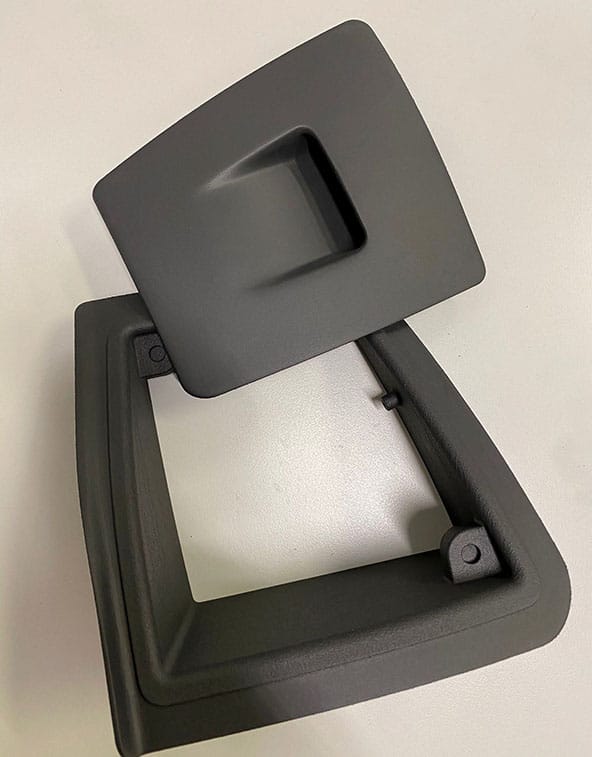Olli 2.0, the autonomous electric vehicle from the ground sustainable mobility company Local Motors, now includes 3D printed parts manufactured by CRP Technology using Windform composite materials.
The Modena-based company, which has been leading in professional 3D printing with Windform composite materials since 1996, was contacted by the EMEA management of Local Motors to build parts, such as windshield wipers, that were mandatory in order to obtain approval for us of the Olli shuttles in Europe.
Carlo Iacovini, General Manager EMEA, Local Motors, explained: “Olli is operating in campuses, stadiums, industrial districts and local communities around the world. To approve deployments in Europe, it needed some additional components, which were not required in US market.”
Challenge
“To add the wipers – Iacovini added – we opted for a retrofit technique, or re-adaptation process, through integration on the 2.0 model. We started from the original project, and we adapted it to our needs. These phases (retrofit and integration) were carried out in Italy, based on the original design produced by the Engineering Team in Chandler.”
It has been a demanding job since Olli 2.0’s unique design is characterized by a tall rectangular pod with wide-set headlights and expansive windows nestled between a frame.
“That’s exactly the reason why the wiper’s arm could not be positioned above,” Iacovini explained, “but had to be positioned on the side, below the front window. Thus, the Local Motors’ Engineering Department designed a new front bumper with brackets for fixing both the wipers starter motor and the front wiper washer reservoir.”

During the wipers assembly phase, the Local Motors Engineering Team noticed that the motor protruded from the modified front bumper: “To avoid the issue we, therefore, thought to add two coordinated covers, with the purpose of concealing the protruding part – the first cover – and protecting the pressure system of the washer reservoir from external agents – the second cover,” – commented Iacovini.
The Local Motors team designed the motor cover from scratch. “For the wipers washer reservoir flap valve – Iacovini specified – we modified and adapted the design of the flap valve of the charging socket on Olli 2.0’s rear bumper. In this way, we maintained homogeneity from the design point of view, and we positioned the water flap valve symmetrically to the charging one.”
Manufacturing on Demand
Once the parts to manufacture were identified – the motor cover and the washer reservoir flap valve of the wipers system – Local Motors turned to CRP Technology: “We wanted to collaborate with a European firm, therefore we contacted CRP Technology, a company I have known for a long time and with which I have collaborated on relevant projects,” Iacovini stated.

Results
The wiper starter motor cover is a rectangular part, produced in the Windform XT 2.0 material, a sort of protruding oblique parallelepiped with a puncture for the placement of the wiper’s arm and a smaller one for the water hose.
The main function of the part is aesthetic, but considering its position (next to the motor) it also has to guarantee electromagnetic compatibility, resist the oscillating movement of the wiper arm and blade, withstand the continuous stress and vibrations caused by the traffic circulation on roads, and preserve the electrical unit from external agents. For these reasons, the part needed to be made of a material that would provide stiffness and strength combined with high lightness, ensuring the creation of an accurate, reliable and durable application. Windform XT 2.0, one of the top-of-the-range materials from the Windform TOP-LINE, was selected as an ideal choice for functional applications.

The wipers washer reservoir’s flap valve component, printed in Windform LX 3.0, consists of a rectangular structure frame and the flap valve equipped with magnets to access the wipers washer reservoir. Its main purpose is to ensure quick access to the wipers washer reservoir positioned behind, to protect it from external agents and to resist the continuous stress and vibrations caused by the traffic circulation on roads. Furthermore, it also has to be accurate in detail. It, therefore, needed to be manufactured in a material that could guarantee reliability, good resistance, and aesthetic return: Windform LX 3.0 was chosen for its properties and wide spectrum of use.
After manufacturing the parts, CRP Technology carried out the final tests. Then, a Local Motors supplier installed them on the Olli without encountering any mounting and fixing issues.
Afterward, Local Motors conducted electromagnetism tests in the anechoic chamber on the “modified” Olli. The EMC testing on the windshield wipers gave excellent results. No critical issues were proposed in regard to the 3D printed parts in Windform composites.
* This article is reprinted from 3D Printing Media Network. If you are involved in infringement, please contact us to delete it.
Author: 3D Printing Media Network

Leave A Comment